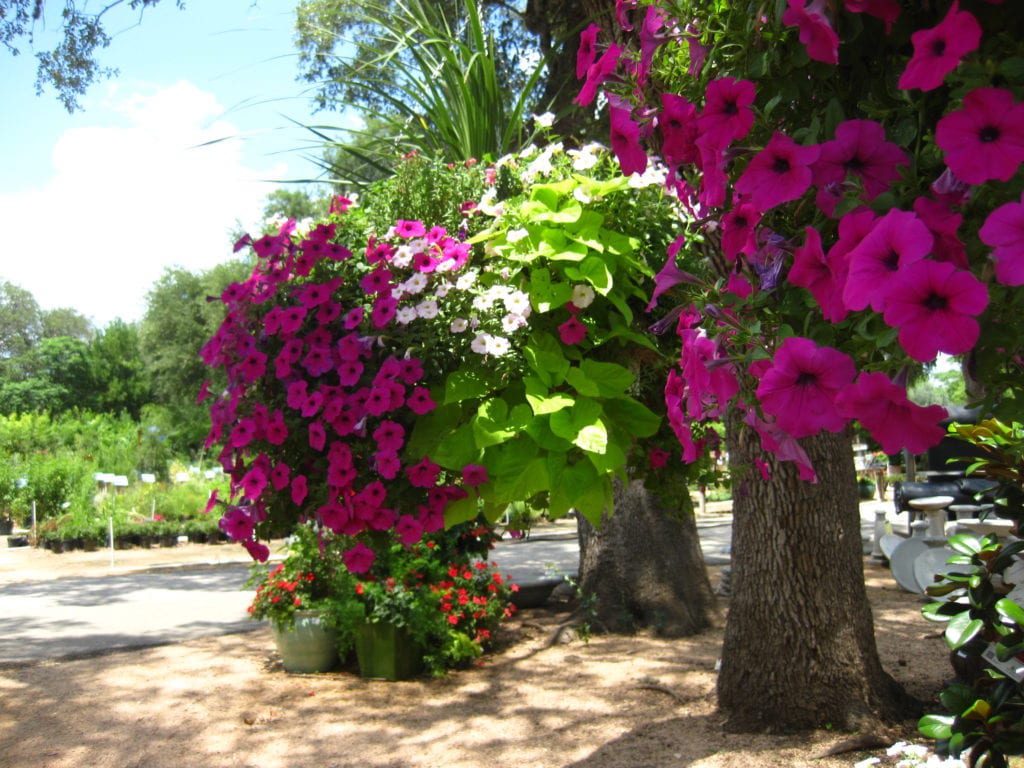To create a great mixed container display, we suggest incorporating a variety of plants with different heights and growth habits for stunning visual appeal. We often call these container arrangements a “thriller, spiller, filler combo”. Today we’ll take a look at some tips we received during our Raised Bed and Container class with FoxFarm, on how to arrange these plants in your pots. We’ll also add in a few ideas for some plants that fit each category to give you some ideas of what to add to your containers or baskets.

Thrillers for Containers and Pots
Thrillers are plants that will have the most height in your containers. Thrillers are situated either in the center of your container if it will be viewed from all sides, or the back of the container if it will be viewed from only one side. They are usually the focal points of your containers.
- Some Thriller options for sun containers: Ornamental Grasses, Palms, Mandevilla (on a trellis) Cordyline, Gaura
- Some Thriller options for shade containers: Spike, Flax Lily, Foxtail Fern, King Kong Coleus, Caladiums, Dracaena
If you are filling up a really large container, your thrillers can even be larger specimens too. Cannas, Bananas, Agave, Elephant Ears, and small shrubs or trees could be your focal points.

Fillers for Containers and Pots
Fillers are plants that have a more rounded or mounding growth form so that they can be used to make your container look lush and full. Filler plants will be planted close to the thriller plant, around it if the thriller has been planted in the center, or in front of it if the thriller is planted towards the back of the container.
- Some Filler options for sun containers: Vinca (periwinkle), Serena Angelonia, smaller Pentas, Moss Rose, Pansies, Johnny Jump Ups, Marigolds, Gazania, Dusty Miller
- Some Filler options for shade containers: Red and Green Waxleaf Begonias, Impatiens, Polka Dot Plant, Coleus
Again, if you are planting a really large container, choose larger filler options like geraniums, lantana, salvias, etc…

Spillers for Containers and Pots
Spillers are added last to the container. They are trailing or cascading types of plants that essentially “spill” over the basket or pot. Again, you place these spillers all around the pot if it will be viewed from all sides, or in the front of the pot if only viewed from one side.
- Some Spiller options for sun containers: Trailing Lantana, Creeping Jenny, Calibrachoa, Wave Petunia, Asparagus Fern, Trailing (Ivy) Geranium, Trailing Vinca (periwinkle), Silver Ponyfoot, Lobelia (part sun)
- Some Spiller options for shade containers: Fig Ivy, Sweet Potato Vine, Vinca Minor, Asiatic Jasmine, Torenia, Asparagus Fern, Silver Ponyfoot, Lobelia (part shade).


Try using a mix of flowering and foliage plants for a variety of colors and textures. You could even make an edible thriller, filler, spiller container. Try an eggplant for your thriller (it’s a gorgeous plant), add some salad greens for a filler and some creeping thyme as a spiller. Laura Jarvis used to have the kids pot up a small “pizza” container combo by planting a basil as a thriller, chives as fillers and trailing oregano as a spiller. You can make these combos in giant pots or fairly small pots. And you don’t have to follow the rules. Not all fillers and spillers have to be the same species. The combinations are practically endless, so have fun with it. Go pot something up!
~The Happy Gardener, Lisa Mulroy


test
test response
Thanks for some fresh ideas on plant selection. I believe in the motto “Go big or stay home” when it comes to container size. Our Texas heat can bake those baskets.
Hi Cathy! Go big or go home is a great line of thinking. And you are right, those smaller pots and baskets can dry out quick in our Texas heat! Thanks for reading!
Love the Edible Trio idea. I’m always looking for something new to try.
Absolutely! There are so many combos you could try. I hope you give it a go!
How much soil do I need for a big pot? I Haven’t purchased pot yet. Is there a formula for dirt according to height and width of pot?
We are about to do a youtube video on “garden math”, which should be released in a couple of weeks. But in the meantime, you might want to check out this site that has a calculator you can enter your pot dimensions in and it will calculate the amount of potting soil needed. Most of our bags of soil are measured in cubic ft., like 1 cu. ft. bag or a 2 cu. ft. bag (you can enter that option in the calculator). It’s kind of neat.